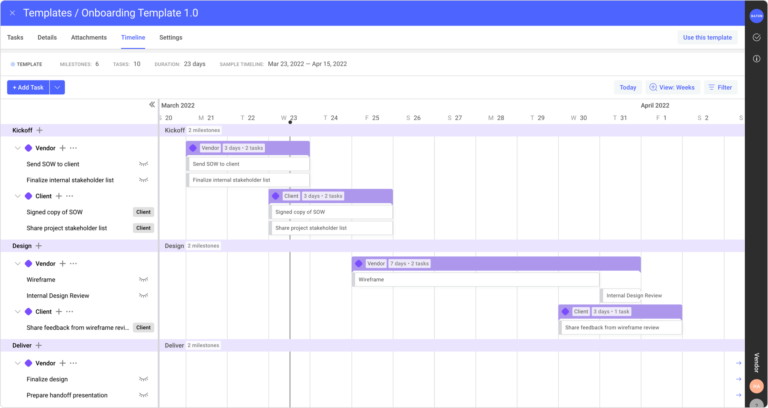Throughout each intricate stage of the customer journey, software implementation and customer onboarding projects have become the backbone of business operations, innovation, and growth. Whether you’re rolling out a new customer relationship management (CRM) system, upgrading an enterprise resource planning (ERP) platform, or launching a cutting-edge mobile application, the success of these projects (and each new customer relationship) hinges on a delicate balance of factors. As a result, adopting a solution that will allow your team to establish standardized implementation and customer onboarding project templates has emerged as a powerful strategy to ensure high-quality standards, timely delivery, and budget adherence.
The Implementation Complexity Conundrum
Software implementation and customer onboarding projects are complex endeavors that demand meticulous planning, coordination, and execution. The multitude of tasks, dependencies, milestones, and stakeholders involved can quickly escalate into a labyrinth of challenges if not managed effectively. This is where the concept of project templatization comes to the rescue.
A templatized approach involves creating standardized templates, guidelines, and processes that can be reused across multiple projects with minimal modification. The essence of templatization lies in developing a structured framework that captures best practices, lessons learned, and proven methodologies. Let’s delve into how this approach can significantly impact the outcomes of your implementation endeavors – helping you grow your business, scale your operations, and avoid dreaded failure-to-launch churn.
1. Project Consistency Breeds Quality
Quality assurance is a cornerstone of successful software implementation projects and customer experiences. When crafting your implementation experience, a purpose-built implementation management solution can help you build a catalogue of reusable project templates for every project type – allowing your team to establish a consistent foundation that ensures high-quality standards are met. Standardized templates help your team follow proven best practices, reducing the risk of errors, bugs, and oversights that can result in costly project delays.
A templatized approach allows you to review trends and incorporate lessons learned from previous projects into your templates, thus preventing the recurrence of past mistakes. Moreover, it promotes better communication, collaboration, and resource allocation amongst team members, as everyone is on the same page, following a unified set of guidelines.

2. Accelerating Project Onboarding & Handoffs
In the dynamic world of software implementation, team members may change, and new talents will come aboard. Templatization significantly accelerates the onboarding process for new team members. Utilizing a project management solution that can act as a centralized system of record with standardized templates, and key project information readily available, newcomers can quickly grasp project specifics, objectives, and workflows.
Efficient onboarding and seamless project handoffs ensure that your team remains productive and focused from the get-go, which translates to faster project progress and smoother collaboration.
When I’ve inherited another manager’s project, it’s helpful to view a history of what’s been completed and understand the current state of the project in Baton. It’s a nice checklist to go through when transitioning active projects over.
May Son, Customer Engagement Manager, Sight Machine
3. Mitigating Implementation Project Risks
Risks are an inherent part of any software implementation project. Unforeseen challenges, scope creep, timeline shifts, and resource constraints can derail even the most well-planned projects. Templatization equips your team with a proactive tool to identify bottlenecks and mitigate risks effectively and get your projects back on track.
By incorporating risk assessment and mitigation strategies into your templates, you create a systematic approach to identify potential pitfalls and plan for contingencies. This helps in reducing project uncertainties, enhancing decision-making, and ultimately safeguarding project timelines and budgets.

4. Optimizing Resource Management & Allocation
Resource management is a delicate balancing act in software implementation. Misallocated resources can lead to delays, inflated budgets, and compromised quality. Utilizing project templates, will help you ensure standard processes are met, timelines are more realistic and strictly adhered to, and will ultimately help you make more informed resource management and allocation decisions based on historical data, trends, and project-specific requirements

By analyzing trends and resource allocation patterns from previous templatized projects, you can optimize your team’s efficiency, allocate resources effectively, and ensure that the right skills are in place at the right time.
5. Enhancing Operational Scalability
In an era of rapid technological advancements, scalability is a key consideration for software implementation projects. Project templatization lends itself naturally to scalability, as the standardized framework can be easily adapted and expanded to accommodate larger, more complex projects.
This adaptability allows your team to take on larger projects with confidence, knowing that the templatized approach will provide the necessary structure and guidance to navigate challenges and deliver successful outcomes.
We are a fast-growing company that is disrupting the logistics TMS world. The growth acceleration is exponential and we needed partners that can align with our vision. Baton was a big part of that by accelerating and improving our implementation process into what it really needs to be.
Alexander Paris, Project Manager, Client Services, LoadStop
6. Facilitating Knowledge Transfer
The knowledge gained from one project should not remain siloed within the team that executed it. Templatization facilitates knowledge transfer by capturing valuable insights, strategies, and best practices in a format that can be easily shared and disseminated.
New team members can tap into this collective knowledge repository, benefiting from the wisdom of experienced colleagues. Additionally, as your organization grows, project templatization ensures that institutional knowledge is preserved and utilized, even as team compositions evolve.

7. Continuous Implementation Process Improvement
Temptation lies in viewing templatization as a static approach. However, the true power of templatization lies in its ability to adapt and improve over time. By regularly revisiting and updating templates based on feedback and evolving industry standards, you foster a culture of continuous improvement.
This iterative approach allows your team to stay agile, embrace new technologies, and refine processes to achieve even higher levels of quality, efficiency, and innovation in each subsequent software implementation project.

The Argument for Utilizing Implementation Project Templates
Templatizing your software implementation projects is not just a one-size-fits-all solution; it’s a strategic approach that empowers your team to consistently deliver high-quality outcomes, meet project deadlines, and stay within budget constraints. By leveraging an implementation management solution to create reusable templates for each project type, you create a solid foundation that ensures a harmonious blend of structure, efficiency, and adaptability.
The software implementation landscape is ever-evolving, but the principles of templatization and quality assurance remain timeless. As you embrace this approach, you equip your team to navigate complexities with confidence, turning challenges into opportunities and paving the way for a future where every implementation project reaches the finish line on time, on budget, and with exceptional quality and customer satisfaction.
Need a purpose-built solution to templatize your implementation projects?
Establish repeatable, standardized implementation and customer onboarding processes that yield predictable outcomes.



